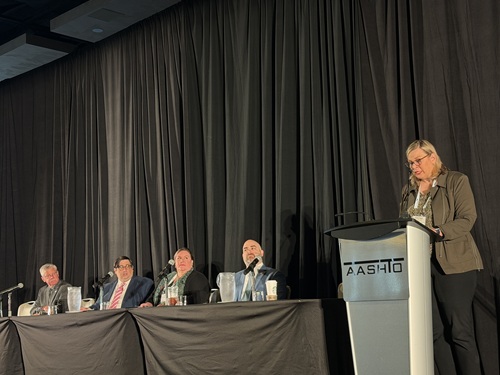Roger Millar (above), secretary of the Washington Department of Transportation and 2022-2023 president of the American Association of State Highway and Transportation Officials, talked why resilience is a critical factor in current and future transportation planning efforts during a visit to AASHTO headquarters in Washington, D.C.
[Above photo by AASHTO]
In town for the four-day AASHTO Executive Institute or AEI conference for state department of transportation executives, Millar explained that resilience – a key emphasis area for his one-year tenure as AASHTO’s president – encompasses a broad range of issues.

“Resilience to me means how we maintain a safe, sound, and smart transportation system – one prepared for a lot more than just climate change,” he pointed out during his presentation to AASHTO’s staff.
“Transportation has to be ready to handle natural and human caused disasters,” Millar said. “But that also includes demographic and economic changes as well. And we as state DOTs have to be prepared for and adapt to whatever happens.”
For example, state DOTs, in their role as stewards of the transportation system, must address the mobility needs of a “changing and growing population,” Millar said – ensuring that the nation’s transportation system is accessible to everyone.

“For example, roughly 25 percent of our [Washington State] state residents don’t drive – that’s about 2 million people and they are our customers, too,” he noted. “So how do we maintain mobility in that situation?”
Addressing that issue involves providing more transportation choices. “It is about how we can make it safe and easy to shift short trips from driving to walking or biking,” Millar said. “Providing those options is part of a larger land-use strategy.”
That’s where the “smart” part of Millar’s resilient transportation focus comes into play. “Being ‘smart’ is about finding ways to get more out of [the transportation infrastructure] we already have – we cannot build our way out of traffic congestion,” he noted.

Millar explained that WSDOT calculated that expanding the state’s highway network to fully eliminate traffic congestion would cost $115 billion, which translates into a state fuel tax increase of $2.50 per gallon.
“That just does not make sense, which is why we must look to transportation demand management, intelligent transportation technology, and other modal options to alleviate congestion,” he said.
“For example, buses represent just 2 percent of the vehicles on our [Washington State] roads; yet they carry 34 percent of people within our high-traffic corridors,” Millar noted.

“That’s why when we talk about ‘system expansion’ what we’re really talking about are deploying more complete street programs, more multimodal options for all, including bicycle and walking trails,” he said.
“It also means creating more transit options and connections, providing more active transportation options such as bicycling and walking,” Millar pointed out.
“It becomes about moving more people and goods, not just vehicles,” he said. “That means we must look at transportation as a means to the ends we want to achieve in the future, be it economic growth, access to economic opportunity, access to healthcare, connections to more affordable housing, and other needs.”
Safety is a crucial piece of this formula as well, Millar emphasized, noting that in addition to the tragic rise of fatalities and injuries on the nation’s roadways due to vehicular crashes over the last several years, there is a huge economic impact from those crashes as well.
For example, the cost of crashes in Washington State on an annual basis tops $18 billion, while the cost of traffic congestion – from wasted fuel, lost time, plus added vehicle wear and tear – totals $2 billion yearly.
[Editor’s note: The National Highway Traffic Safety Administration released a study in January showing that motor vehicle crashes cost American society $340 billion in 2019. That report – “The Economic and Societal Impact of Motor Vehicle Crashes, 2019” – examined the costs of one year of crashes that killed an estimated 36,500 people, injured 4.5 million, and damaged 23 million vehicles.]
“Crashes on our system cost our state nine times what traffic congestion costs us every year,” Millar said.
“More importantly, the [crash fatality and injury] numbers are going the wrong way; they are going up – particularly for bicyclists and pedestrians,” he said.
“That’s why we are going to have safety summit in October so we can do a ‘stand down’ and undergo a complete reset where safety is concerned,” Millar said. “We need to do something about this.”
 Top Stories
Top Stories
Collaboration Touted at AASHTO’s Third Safety Summit
October 31, 2025 Top Stories
Top Stories

